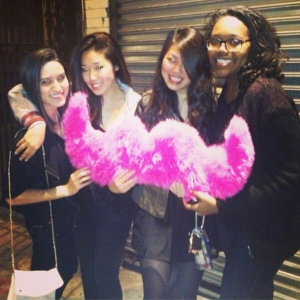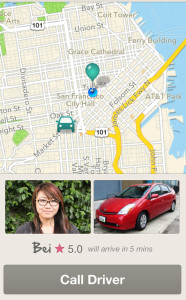It is Saturday night. You and your friends are planning to go downtown for a few drinks. Instead of calling a cab, someone takes out her Iphone and books a ride with Patrick. He has a friendly smile, a five-star rating, and a white Toyota—with a pink mustache.
Lyft is a ride-sharing app that markets itself as “a friend with a car.” The economic transaction is more than just an exchange of service; it’s an experience. The app is free and syncs to your smart-phone. At any point in time, you can open up the app and hail a friendly Lyft driver around the area.
You enter the car, give the driver a fist-pump, and he or she entertains you with a friendly conversation as you are dropped off at your location. The transaction is processed by Lyft so you avoid the awkward paying and tipping process. Lyft raised $60 million in its third round funding last May with venture firm Andreessen Horowitz and company has grown to be available in 22 cities.
According to TechCrunch, Lyft is currently growing at a faster pace than its main competitor, Uber, with a 6% growth rate disclosed my its co-founder, John Zimmer (TechCrunch). Lyft has especially been popular especially with the tech-savvy and thrifty Millennial generation. Katherine, a college student from California, says it has to do with convenience and saving money.
“I use Lyft because it feels more personal and I feel like I can trust the drivers more. Plus it’s convenient to find a car from an app on my phone – I never know which number to call for a taxi or what service is better than another. Plus it’s cheaper. A ride to downtown via taxi can be $14, while using Lyft, I can get a rate as cheap as $8.”
If we dive further into the success of Lyft, we can find there are multiple economic forces at play. The first is the economic recession. In tough times, people are gathering part-time jobs to make ends meet. For instance, Patrick started Lyft to make more money on the side.
“I needed a second job to help pay some bills and also to help save up for grad school. I do see myself doing this long term because I can make some extra cash and not have it interfere with my regular work schedule.”
In every transaction, Lyft gets 20% of the cut. There are also “Prime Time Tips,” that escalates rates during high-demand periods (i.e. 11pm on a Saturday night). These tips can go as high as 70%, but the entirety of the increase goes to the drivers. Lyft gets to bypass the system by asking for “donations” rather than charging “fares.” The legality of this is as fuzzy as Lyft’s iconic pink mustache, evidenced by the app’s ban in certain cities like Seattle. However, this does not mean Lyft does not take safety seriously. In some aspects, Lyft’s screening process is harsher than some taxi companies, with higher standards on criminal records, and linking your Facebook for safety and providing insurance of up to $1m for the drivers. The car also has to be clean and presentable.
Another economic factor is proliferation of mobile technology. “There’s an app for that” is a common slogan in response to every day problems. Technology of apps and mobile phones have allowed companies like Lyft to reduce transaction costs. People are able to conduct business with private individuals rather than a chain. Perhaps ironically, through innovation, our generation is reverting back to a peer to peer localized model. People have referred to this phenomenon as the sharing economy, or collaborative consumption.
Rachel Botsman, the co-author of What’s Mine Is Yours: The Rise of Collaborative Consumption, talks about how technology is enabling trust between strangers, and this concept of collaborative consumption is a “powerful cultural and economic force reinventing not just what we consume, but how we consume.” Botsman writes collaborative consumption is a class of economic arrangements in which participants share access to products or services, rather than having individual ownership.
Named as one of TIME’s 10 ideas that will change the world in 2011, the concept of collaborative consumption has proved it is a force to be reckoned with. Botsman co-wrote the book in 2010, and since then, the concept has taken the app world by storm, with giants like Airbnb, Uber and Lyft rounding billions from venture capitalists. However, this new concept is disrupting the economic system. In Lyft’s case, the service is a huge threat to the taxi and limo service industry. Formally trained drivers who are screened in a testing and licensing system are now competing with normal civilians. In essence, the barriers to entry to the transportation industry has been compromised.
There has also been tensions between governments and the new model. In 2012, the California Public Utilities Commission issued “cease and desist” letters to Lyft along with other similar services. Although the knee-jerk reaction may be the issue of safety, there are many factors contributing to the debate of this new business model. Taxi and limousine companies who once enjoyed monopolies are heavily lobbying against legalizing these services. In addition, many cities rely on the regulation fees these companies pay to operate, fees private ride sharing programs are not obliged to pay.
“To me it’s a really dumb debate,” Patrick says.
“The real concern for the state of California and other states that Lyft operates in is that they see private ride sharing programs as entities that are taking money from them. They hide under the issue of safety, but their arguments are based off of taxi companies having to pay fees regulated by the state while private ride sharing programs do not. How does that equate to being concerned about passenger safety? It’s really ridiculous.”
The issue of safety is always brought up in these debates. However, it seems like Millennials have more faith in strangers. Katherine says “the idea of communicating even with a stranger online isn’t quite as daunting anymore.”
“There’s a growing inherent trust between young people in this generation (twenty-somethings), so doing things like calling a cab or organizing a ride share through an app or online service doesn’t seem so out of ordinary, and most don’t think anyone is trying to scam them.”
Patrick says the age of his passengers range from 21-45, which is consistent with the wide belief ride-sharing is embraced mostly by the Millennial generation. Botsman asserts that we now live in a global village, and there is a new importance of reputation. In Lyft’s case, transactions are followed by a rating system, from these reviews these drivers and users leave a trail. If you average less than 4.5 stars, you are in danger of being dropped. Our ability to collaborate is quantified into a form of “reputation capital,” and it is put in public display, and ultimately determining our access to collaborative consumption.
Last September, the State of California became the first state to regulate ride-sharing, or what is now newly dubbed as “transportation network companies.” Depending on how these new rules perform, other cities may follow the California framework in the future.


Leave a Reply
You must be logged in to post a comment.